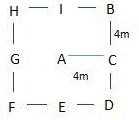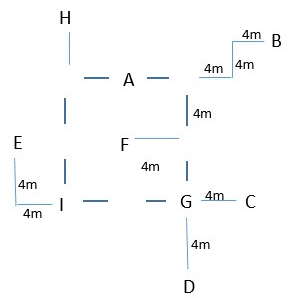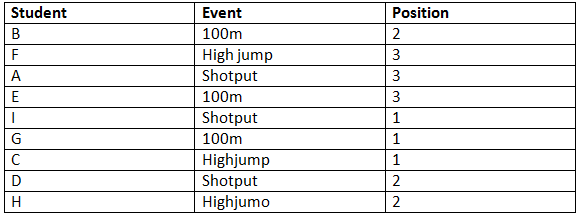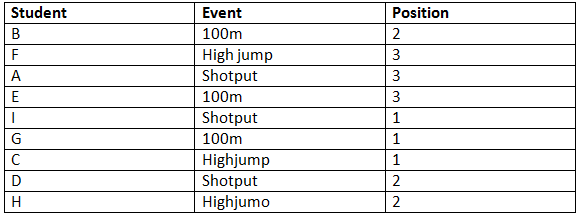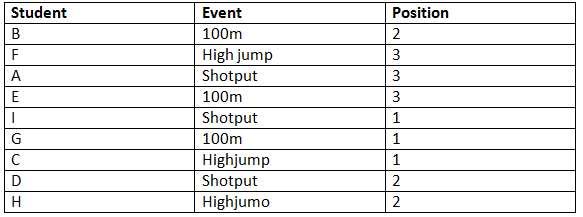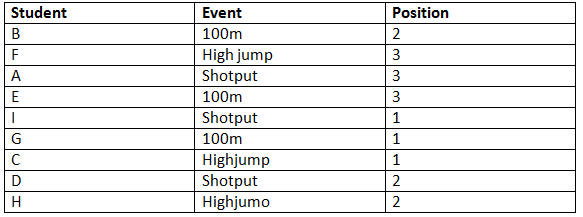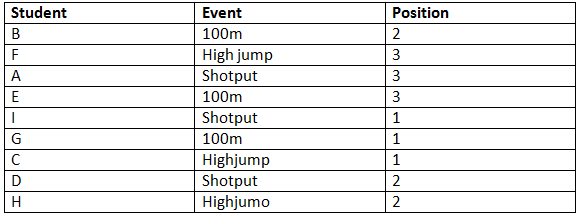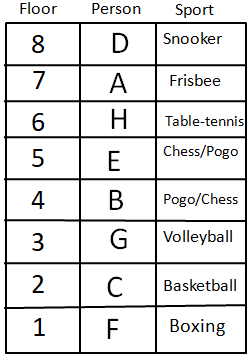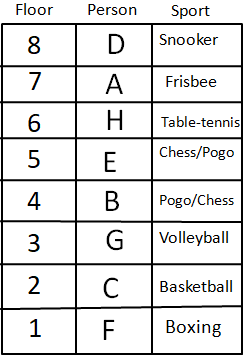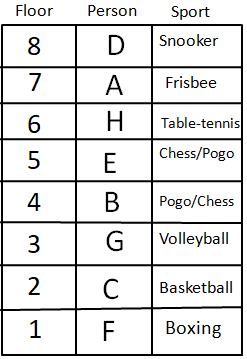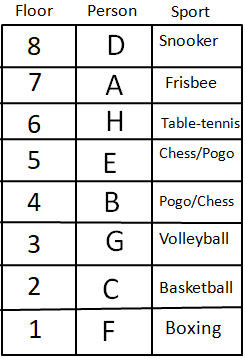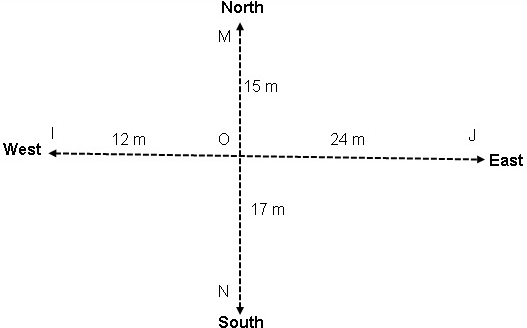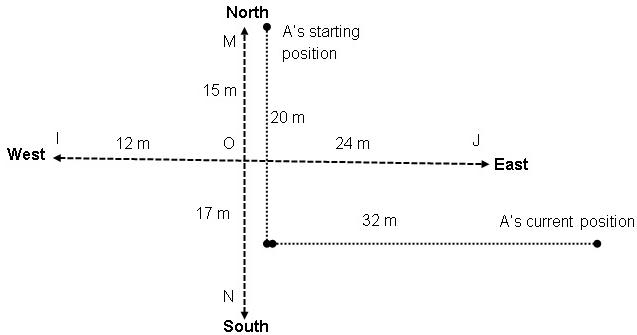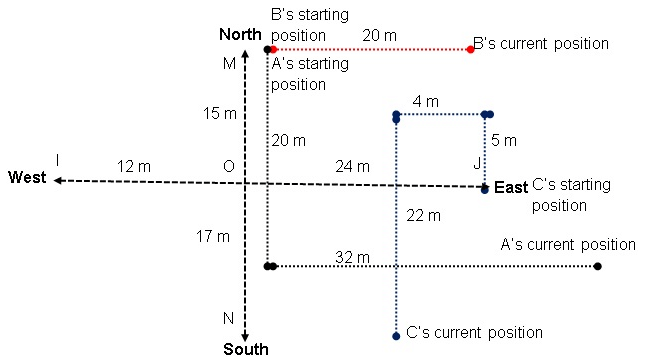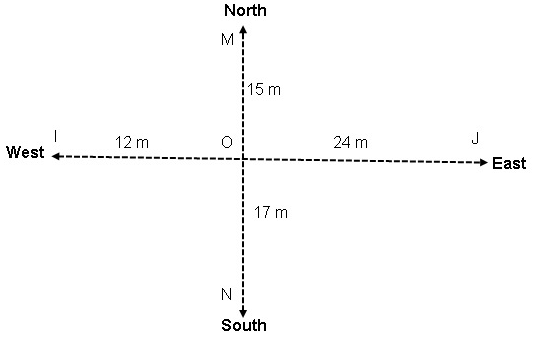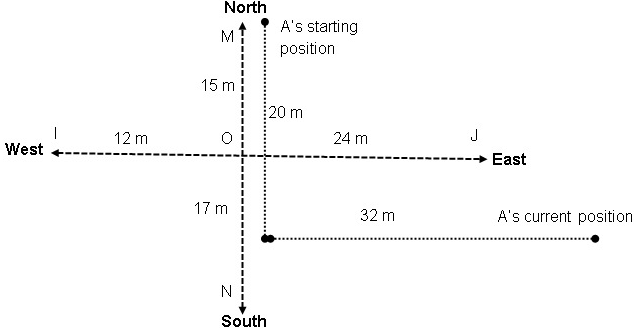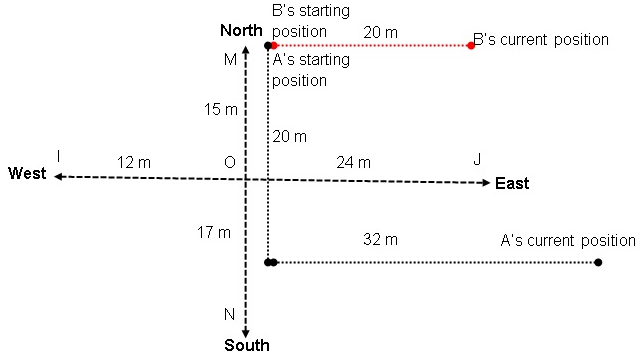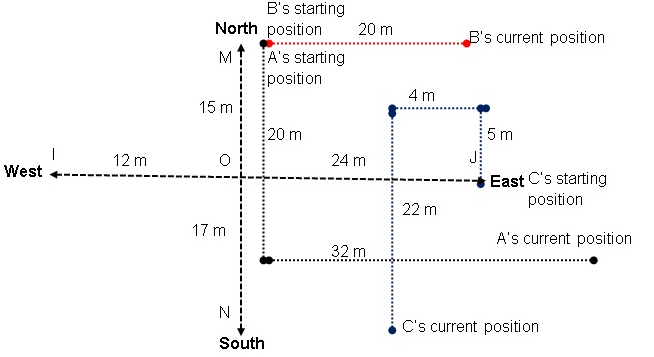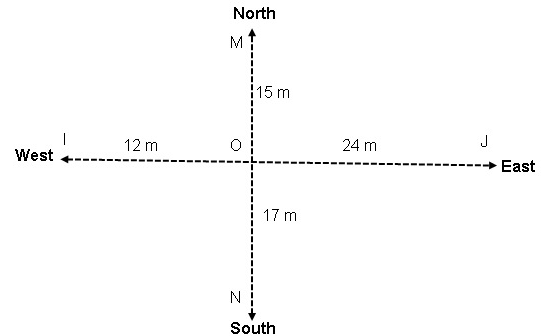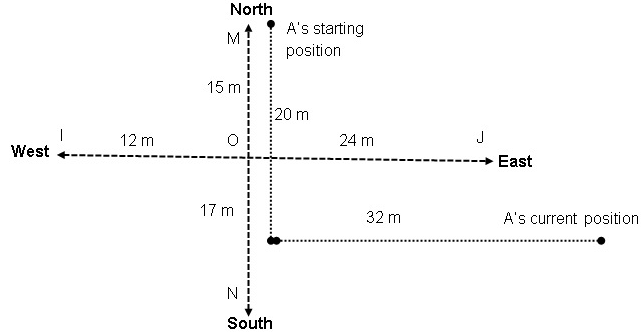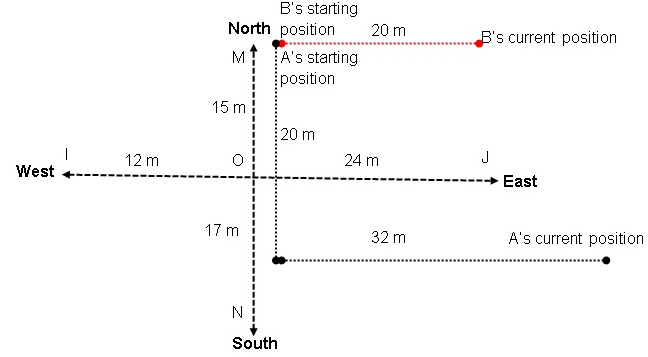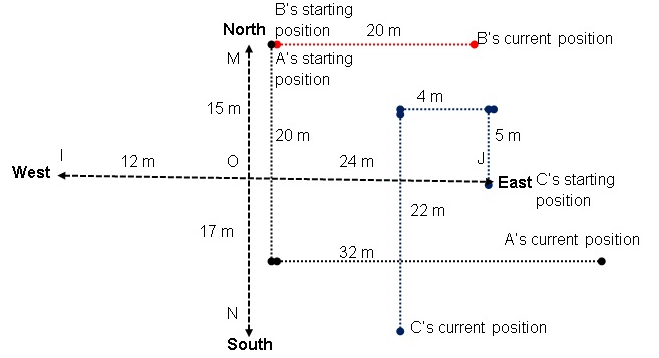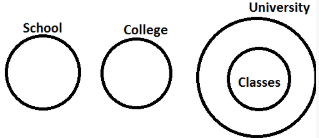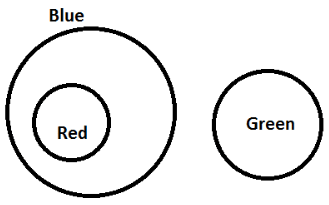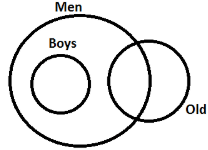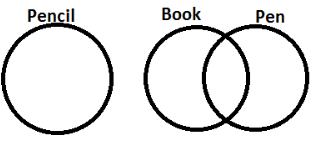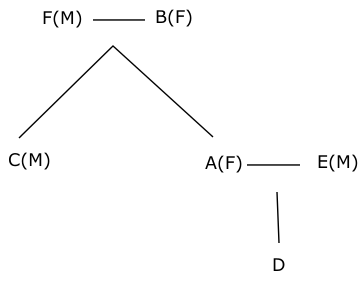IBPS PO Mains Mock Test - 1 - Bank Exams MCQ
30 Questions MCQ Test - IBPS PO Mains Mock Test - 1
Study the given information carefully and answer the given questions.
Nine dogs (A,B,C,D,E,F,G,H,I) are participating in a dog show and forming different patterns. All dogs are standing forming a square such that, H,B,D,F are at the consecutive corners of the square and H stands in the North west direction with respect to A. I,C,E,G are standing at the center of each side of square such that I is between H and B and is 4 m to the North of A, C is between B and D, E is between D and F, G is between H and F. A is standing inside the square, in the center and each dog standing at the center of each side is 4 meters away from it. The length of each side of square is 8m.
H moves 4m towards North and D moves 4 m towards south. C moves 4 meter towards south and then turns left and walks for another 4 meters and stops.
B moves 4 meter towards East and then turns left and walks for another 4 m and then turns right and walks for another 4 m.
G moves 8 m East and then turns right and walks for another 4m. F walks 4 m North and turns towards its right and walks for another 4 m. I walks 4 m West and then turns left and walks for other 8 m.
A walks 4√2 m towards South East direction and then it starts moving towards north for 8 m and then walks for other 4 m after turning left. E walks 8 m towards West and then turns right and walks for 4m and stops.
Q. In which direction is A with respect to its initial position?
Study the given information carefully and answer the given questions.
Nine dogs (A,B,C,D,E,F,G,H,I) are participating in a dog show and forming different patterns. All dogs are standing forming a square such that, H,B,D,F are at the consecutive corners of the square and H stands in the North west direction with respect to A. I,C,E,G are standing at the center of each side of square such that I is between H and B and is 4 m to the North of A, C is between B and D, E is between D and F, G is between H and F. A is standing inside the square, in the center and each dog standing at the center of each side is 4 meters away from it. The length of each side of square is 8m.
H moves 4m towards North and D moves 4 m towards south. C moves 4 meter towards south and then turns left and walks for another 4 meters and stops.
B moves 4 meter towards East and then turns left and walks for another 4 m and then turns right and walks for another 4 m.
G moves 8 m East and then turns right and walks for another 4m. F walks 4 m North and turns towards its right and walks for another 4 m. I walks 4 m West and then turns left and walks for other 8 m.
A walks 4√2 m towards South East direction and then it starts moving towards north for 8 m and then walks for other 4 m after turning left. E walks 8 m towards West and then turns right and walks for 4m and stops.
Q. Which of the following combinations of dogs are in a straight line?
Study the following information carefully and answer the questions given below:
A, B, C, D, E, F, G, H and I are high school students of PK Public School who are the winners(1st, 2nd, 3rd) of three sports events 100m race, shot put and high jump. No student participated in more than one event and no two students are tied at the same position. The following information is also known:
(i) B won the second prize in 100m race.
(ii) A, D and I won prizes in the same event.
(iii) F is third in high jump and G did not participate in high jump.
(iv) A and E won third places in the events they participated.
(v) I, G and C won the first place in their respective events.
Who are the three that won the second place in the events they participated?
Study the following information carefully and answer the questions given below:
A, B, C, D, E, F, G, H and I are high school students of PK Public School who are the winners(1st, 2nd, 3rd) of three sports events 100m race, shot put and high jump. No student participated in more than one event and no two students are tied at the same position. The following information is also known:
(i) B won the second prize in 100m race.
(ii) A, D and I won prizes in the same event.
(iii) F is third in high jump and G did not participate in high jump.
(iv) A and E won third places in the events they participated.
(v) I, G and C won the first place in their respective events.
Who finished third in 100m race?
Study the following information carefully and answer the questions given below:
A, B, C, D, E, F, G, H and I are high school students of PK Public School who are the winners(1st, 2nd, 3rd) of three sports events 100m race, shot put and high jump. No student participated in more than one event and no two students are tied at the same position. The following information is also known:
(i) B won the second prize in 100m race.
(ii) A, D and I won prizes in the same event.
(iii) F is third in high jump and G did not participate in high jump.
(iv) A and E won third places in the events they participated.
(v) I, G and C won the first place in their respective events.
Who won the second place in shot put?
Study the following information carefully and answer the questions given below:
A, B, C, D, E, F, G, H and I are high school students of PK Public School who are the winners(1st, 2nd, 3rd) of three sports events 100m race, shot put and high jump. No student participated in more than one event and no two students are tied at the same position. The following information is also known:
(i) B won the second prize in 100m race.
(ii) A, D and I won prizes in the same event.
(iii) F is third in high jump and G did not participate in high jump.
(iv) A and E won third places in the events they participated.
(v) I, G and C won the first place in their respective events.
The exact positions of how many students can be found out from the information given?
Study the following information carefully and answer the questions given below:
A, B, C, D, E, F, G, H and I are high school students of PK Public School who are the winners(1st, 2nd, 3rd) of three sports events 100m race, shot put and high jump. No student participated in more than one event and no two students are tied at the same position. The following information is also known:
(i) B won the second prize in 100m race.
(ii) A, D and I won prizes in the same event.
(iii) F is third in high jump and G did not participate in high jump.
(iv) A and E won third places in the events they participated.
(v) I, G and C won the first place in their respective events.
What is the position and event in which H participated?
Over the last twenty years, the rate of increase in total population of country ‘X’ has been second in the world. Hence, the economic growth is more modest when per capita of total population is calculated. Over the last ten years, the progress has been very slow. According to the passage, which of the following must be true?
8 friends A, B, C, D, E, F, G and H live on 8 different floors of a building. The floors are numbered from 1 to 8. Each of these eight friends like one of the sports among chess, pogo, snooker, table-tennis, boxing, basketball, volleyball and frisbee. Further, the following information is also known
A lives on a floor which is 3 floors above B’s floor. None of them like basketball and none of them live at the highest or lowest floor.
The person who likes snooker lives on the top floor and the person who lives immediately below the C’s floor likes boxing.
There is exactly one person who lives between H and D. H likes table-tennis and lives on a floor whose number is lower than that of D.
2 people live between C and E and C is not a neighbour of B. Neither E nor B likes frisbee.
G lives on third floor and likes volleyball. E does not like basketball.
Q. Which of the following is definitely true?
8 friends A, B, C, D, E, F, G and H live on 8 different floors of a building. The floors are numbered from 1 to 8. Each of these eight friends like one of the sports among chess, pogo, snooker, table-tennis, boxing, basketball, volleyball and frisbee. Further, the following information is also known
A lives on a floor which is 3 floors above B’s floor. None of them like basketball and none of them live at the highest or lowest floor.
The person who likes snooker lives on the top floor and the person who lives immediately below the C’s floor likes boxing.
There is exactly one person who lives between H and D. H likes table-tennis and lives on a floor whose number is lower than that of D.
2 people live between C and E and C is not a neighbour of B. Neither E nor B likes frisbee.
G lives on third floor and likes volleyball. E does not like basketball.
Q. Who lives on the fifth floor?
8 friends A, B, C, D, E, F, G and H live on 8 different floors of a building. The floors are numbered from 1 to 8. Each of these eight friends like one of the sports among chess, pogo, snooker, table-tennis, boxing, basketball, volleyball and frisbee. Further, the following information is also known
A lives on a floor which is 3 floors above B’s floor. None of them like basketball and none of them live at the highest or lowest floor.
The person who likes snooker lives on the top floor and the person who lives immediately below the C’s floor likes boxing.
There is exactly one person who lives between H and D. H likes table-tennis and lives on a floor whose number is lower than that of D.
2 people live between C and E and C is not a neighbour of B. Neither E nor B likes frisbee.
G lives on third floor and likes volleyball. E does not like basketball.
Q. Who likes snooker?
8 friends A, B, C, D, E, F, G and H live on 8 different floors of a building. The floors are numbered from 1 to 8. Each of these eight friends like one of the sports among chess, pogo, snooker, table-tennis, boxing, basketball, volleyball and frisbee. Further, the following information is also known
A lives on a floor which is 3 floors above B’s floor. None of them like basketball and none of them live at the highest or lowest floor.
The person who likes snooker lives on the top floor and the person who lives immediately below the C’s floor likes boxing.
There is exactly one person who lives between H and D. H likes table-tennis and lives on a floor whose number is lower than that of D.
2 people live between C and E and C is not a neighbour of B. Neither E nor B likes frisbee.
G lives on third floor and likes volleyball. E does not like basketball.
Q. If all people are given floors in alphabetical order, like A is given 1, B is given 2 and so on, then for how many people will their position remain unchanged?
8 friends A, B, C, D, E, F, G and H live on 8 different floors of a building. The floors are numbered from 1 to 8. Each of these eight friends like one of the sports among chess, pogo, snooker, table-tennis, boxing, basketball, volleyball and frisbee. Further, the following information is also known
A lives on a floor which is 3 floors above B’s floor. None of them like basketball and none of them live at the highest or lowest floor.
The person who likes snooker lives on the top floor and the person who lives immediately below the C’s floor likes boxing.
There is exactly one person who lives between H and D. H likes table-tennis and lives on a floor whose number is lower than that of D.
2 people live between C and E and C is not a neighbour of B. Neither E nor B likes frisbee.
G lives on third floor and likes volleyball. E does not like basketball.
Four of the following options are alike in a certain way and hence form a group. Identify the one that doesn't belong to the group.
Direction: Read the following information carefully and answer the question given below-
There are MN axis in such a way that M is in north and N is in south direction. There is IJ axis in such a way that I is in west direction and J is in east direction. MN axis and IJ axis intersect at a point O in such a way that MO is 15m, ON is 17m, OI is 12m, OJ is 24 m. A starts from point M and walks 20m in south direction and then he turns his left and walks 32m. B starts from point M and walks 20m in east direction. C starts from point J and walks 5m in north direction and then he turns his left and walk 4m and again he turns his left and walks 22m.
Point M is in which direction with respect to C’s current position?
Direction: Read the following information carefully and answer the question given below-
There are MN axis in such a way that M is in north and N is in south direction. There is IJ axis in such a way that I is in west direction and J is in east direction. MN axis and IJ axis intersect at a point O in such a way that MO is 15m, ON is 17m, OI is 12m, OJ is 24 m. A starts from point M and walks 20m in south direction and then he turns his left and walks 32m. B starts from point M and walks 20m in east direction. C starts from point J and walks 5m in north direction and then he turns his left and walk 4m and again he turns his left and walks 22m.
What is the distance between B’s current position and A’s current position?
Direction: Read the following information carefully and answer the question given below-
There are MN axis in such a way that M is in north and N is in south direction. There is IJ axis in such a way that I is in west direction and J is in east direction. MN axis and IJ axis intersect at a point O in such a way that MO is 15m, ON is 17m, OI is 12m, OJ is 24 m. A starts from point M and walks 20m in south direction and then he turns his left and walks 32m. B starts from point M and walks 20m in east direction. C starts from point J and walks 5m in north direction and then he turns his left and walk 4m and again he turns his left and walks 22m.
Point N is in which direction with respect to B’s current position?
Direction: In the question below are statements followed by two conclusions numbered I and II You have to take the two given statements to be true even if they seem to be at variance from commonly known facts and then decide which of the given conclusions logically follows from the given statements disregarding commonly known facts?
Statements:
No school is a college.
No college is a university.
All classes are universities.
Conclusion:
I) No college is a class
II) No university is a college
In the question below are statements followed by two conclusions numbered I and II You have to take the two given statements to be true even if they seem to be at variance from commonly known facts and then decide which of the given conclusions logically follows from the given statements disregarding commonly known facts?
Statements:
No blue is green.
All red are blue.
Conclusion:
I) At least some green are red.
II) No green is red.
In the question below are statements followed by two conclusions numbered I and II You have to take the two given statements to be true even if they seem to be at variance from commonly known facts and then decide which of the given conclusions logically follows from the given statements disregarding commonly known facts?
Statements:
All tigers are cats.
Some cats are dogs.
Conclusion:
I) Some dogs are tigers.
II) At least some dogs are cats.
Direction: In the question below are statements followed by two conclusions numbered I and II You have to take the two given statements to be true even if they seem to be at variance from commonly known facts and then decide which of the given conclusions logically follows from the given statements disregarding commonly known facts?
Statements:
No old is boy.
Some men are old.
Conclusion:
I) All boys can be men
II) Some boys are not men
Direction: In the question below are statements followed by two conclusions numbered I and II You have to take the two given statements to be true even if they seem to be at variance from commonly known facts and then decide which of the given conclusions logically follows from the given statements disregarding commonly known facts?
Statements:
No book is a pencil.
No pen is a pencil.
Conclusion:
I) No pencil is a book
II) No pencil is a pen
Direction: Read the following information carefully and answer the question given below-
In the given questions, two rows are given and to find out the resultant of a particular row following rules are given.
Step 1 – If an odd number is followed by a even number then the resultant comes by multiplying the numbers.
Step 2 – If an even number is followed by an odd non prime number then the resultant will be the subtraction of two numbers.
Step 3 – If an even number is followed by prime number (except 2) then the resultant will be the addition of two numbers.
Step 4 – If an odd number is followed by a perfect cube then the resultant will be the subtraction of two numbers.
Step 5 – If an odd number is followed by another odd number then the resultant will be the addition of both the numbers.
Q. Find the addition of the resultant of two rows.
15 10 15
35 45 13
Direction: Read the following information carefully and answer the question given below-
In the given questions, two rows are given and to find out the resultant of a particular row following rules are given.
Step 1 – If an odd number is followed by a even number then the resultant comes by multiplying the numbers.
Step 2 – If an even number is followed by an odd non prime number then the resultant will be the subtraction of two numbers.
Step 3 – If an even number is followed by prime number (except 2) then the resultant will be the addition of two numbers.
Step 4 – If an odd number is followed by a perfect cube then the resultant will be the subtraction of two numbers.
Step 5 – If an odd number is followed by another odd number then the resultant will be the addition of both the numbers.
Q. If X is the resultant of second row. Find the multiplication of the resultant of two rows?
X 6 15
45 33 3
Direction: Read the following information carefully and answer the question given below-
In the given questions, two rows are given and to find out the resultant of a particular row following rules are given.
Step 1 – If an odd number is followed by a even number then the resultant comes by multiplying the numbers.
Step 2 – If an even number is followed by an odd non prime number then the resultant will be the subtraction of two numbers.
Step 3 – If an even number is followed by prime number (except 2) then the resultant will be the addition of two numbers.
Step 4 – If an odd number is followed by a perfect cube then the resultant will be the subtraction of two numbers.
Step 5 – If an odd number is followed by another odd number then the resultant will be the addition of both the numbers.
Q. Find the difference of the resultant of two rows. If A is the resultant of first row.
9 216 6
A 5 11
Direction: Read the following information carefully and answer the question given below-
In the given questions, two rows are given and to find out the resultant of a particular row following rules are given.
Step 1 – If an odd number is followed by a even number then the resultant comes by multiplying the numbers.
Step 2 – If an even number is followed by an odd non prime number then the resultant will be the subtraction of two numbers.
Step 3 – If an even number is followed by prime number (except 2) then the resultant will be the addition of two numbers.
Step 4 – If an odd number is followed by a perfect cube then the resultant will be the subtraction of two numbers.
Step 5 – If an odd number is followed by another odd number then the resultant will be the addition of both the numbers.
Q. Find the difference of resultant of two rows?
8 11 8
26 21 7
Direction: In the following question, a set of four statements is followed by five conclusions, one of which definitely does not follow (or is not a possibility of occurrence). Choose that conclusion as the answer.
Statement:
Some gardens are keys.
All keys are buildings.
No building is a flat.
All flats are floors.
Conclusion:
I. Some floors are gardens.
II. Some floors are buildings.
III. Some flats are gardens.
IV. Some buildings are gardens.
V. Some flats are keys
Direction: Read the following information carefully and answer the question given below-
Seven friends I, J, K, L, M, N and O had their houses situated along a straight row facing the north. They like different colours among Golden, Silver, Purple, Grey, Violet, Indigo and Brown but not necessarily in the same order. The distance between the adjacent houses was a successive integral multiple of 5km and the distance increased from left to right.
I’s house was third to the left of the friend who likes Indigo colour. J’s house was 135km to the right of the friend who likes Grey colour. K’s house was exactly between O’s house and the friend who likes brown colour. The friend who likes violet colour was to the immediate left of the friend who likes purple colour. The friend who likes purple colour was 115km to the left of L’s house. The friend who likes indigo colour was the neighbour of L’s house. The friend who likes grey colour was 85km away from M’s house. The friend who likes golden colour had house at one of the extreme ends. O did not like silver colour. The distance between any two adjacent houses was less than 80 km.
Which colour does N likes?
Direction: Read the following information carefully and answer the question given below-
Seven friends I, J, K, L, M, N and O had their houses situated along a straight row facing the north. They like different colours among Golden, Silver, Purple, Grey, Violet, Indigo and Brown but not necessarily in the same order. The distance between the adjacent houses was a successive integral multiple of 5km and the distance increased from left to right.
I’s house was third to the left of the friend who likes Indigo colour. J’s house was 135km to the right of the friend who likes Grey colour. K’s house was exactly between O’s house and the friend who likes brown colour. The friend who likes violet colour was to the immediate left of the friend who likes purple colour. The friend who likes purple colour was 115km to the left of L’s house. The friend who likes indigo colour was the neighbour of L’s house. The friend who likes grey colour was 85km away from M’s house. The friend who likes golden colour had house at one of the extreme ends. O did not like silver colour. The distance between any two adjacent houses was less than 80 km.
Q. How many houses are there between I and the friend who likes silver colour?
Direction: Read the following information carefully and answer the question given below-
Seven friends I, J, K, L, M, N and O had their houses situated along a straight row facing the north. They like different colours among Golden, Silver, Purple, Grey, Violet, Indigo and Brown but not necessarily in the same order. The distance between the adjacent houses was a successive integral multiple of 5km and the distance increased from left to right.
I’s house was third to the left of the friend who likes Indigo colour. J’s house was 135km to the right of the friend who likes Grey colour. K’s house was exactly between O’s house and the friend who likes brown colour. The friend who likes violet colour was to the immediate left of the friend who likes purple colour. The friend who likes purple colour was 115km to the left of L’s house. The friend who likes indigo colour was the neighbour of L’s house. The friend who likes grey colour was 85km away from M’s house. The friend who likes golden colour had house at one of the extreme ends. O did not like silver colour. The distance between any two adjacent houses was less than 80 km.
Q. What is the distance between K and the friend who likes purple colour?
Direction: A, B, C, D, E and F are six family members, who were spread across three generations.
Further, the following information is also known:
* There are two married couples in the family.
* F is the father of C.
* C is the maternal uncle of D.
* E is the son in law of B.
* There are no single-mothers/fathers in the family.
How is B related to D?


